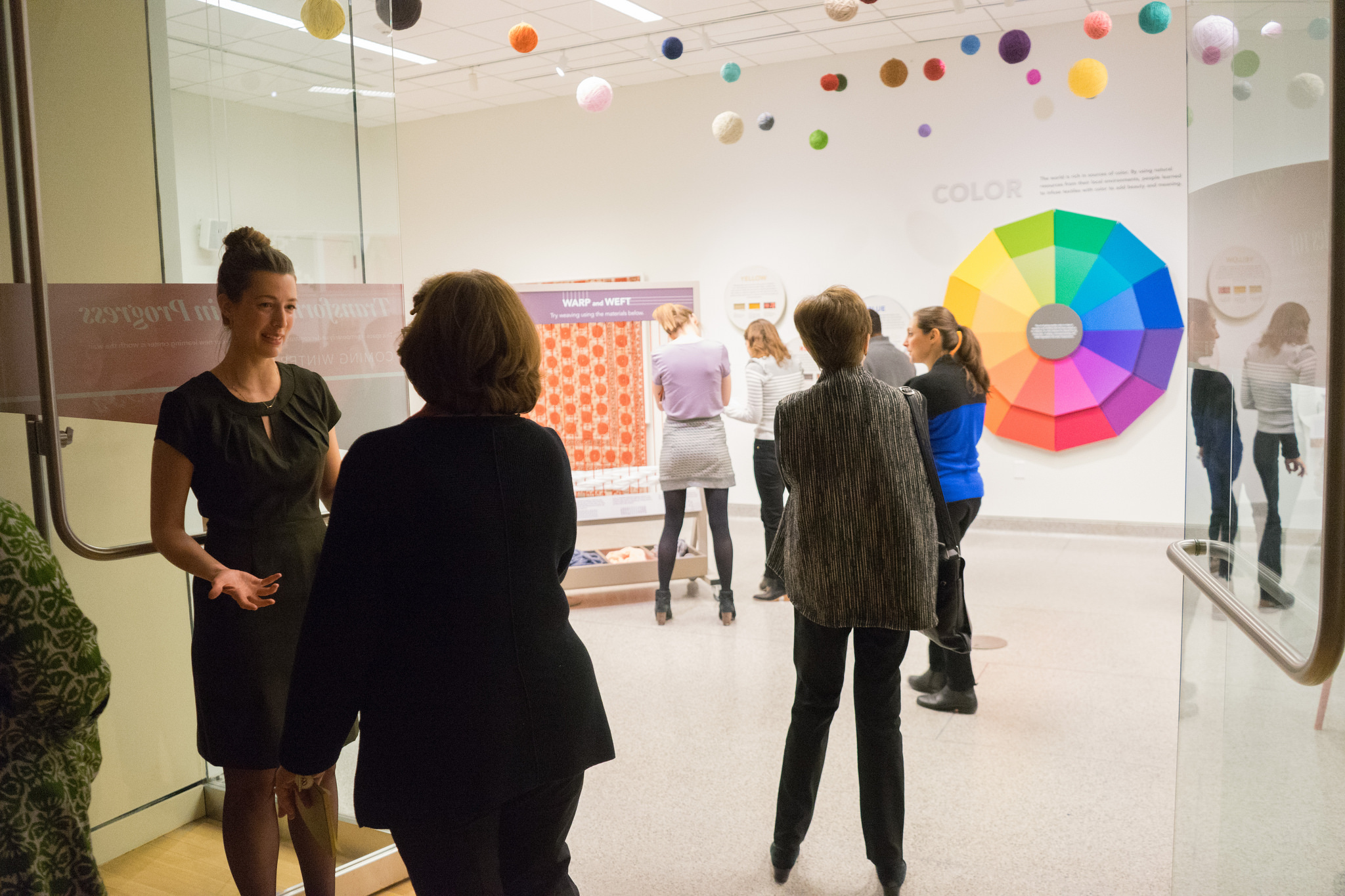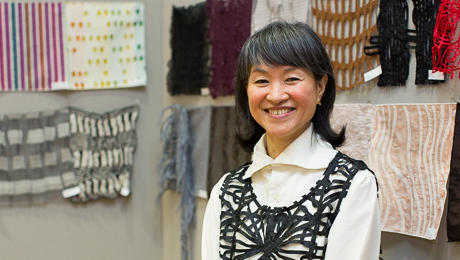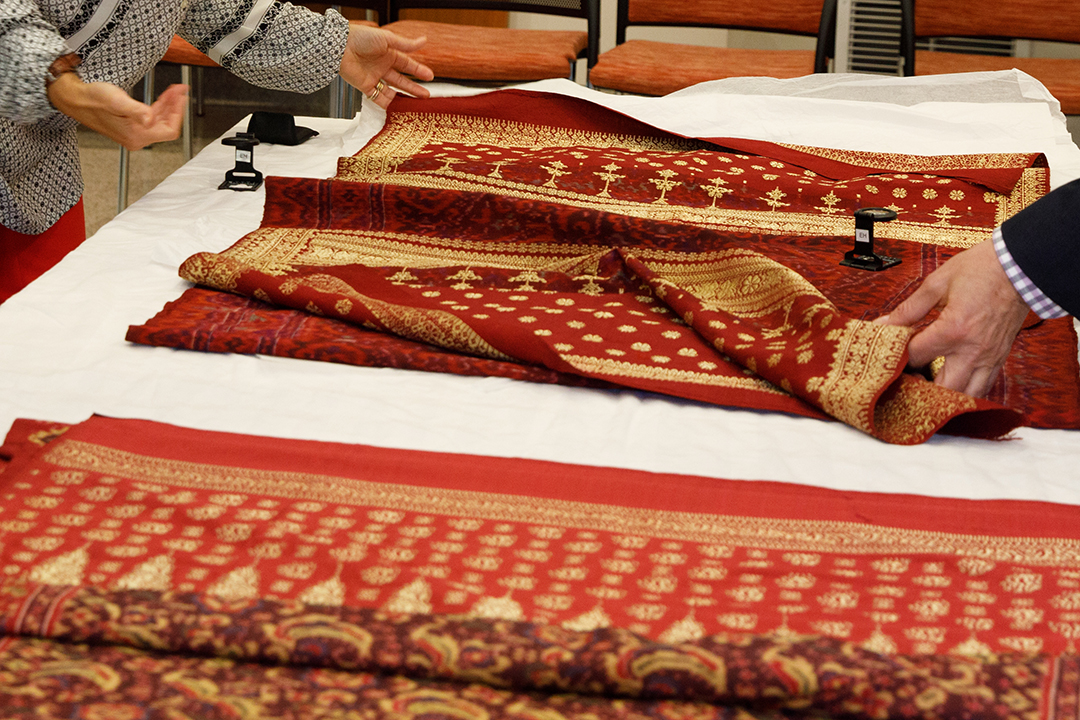By Ruth Steinhardt
In the cool underground exhibit space of the George Washington University Museum and The Textile Museum, a huge color wheel stands out on the wall of one brightly lit room. Next to the wheel, panels explain how certain dye colors are achieved. Whimsical knit pieces by local artists demonstrate the difference between dry felting and wet, or between macramé and crochet. Lengths of thick pink and blue yarn snake through a simple demonstration loom. In a corner, a file cabinet contains pieces from the museum’s study collection, including a brocade silk robe and even a small carpet. Almost everything in the room is something visitors are allowed—and encouraged—to touch.
This is Textiles 101, the museum’s new interactive gallery. Its current incarnation is the brainchild of Lori Kartchner, programs associate of museum collections and a GW master’s degree alumna of the Museum Education Program (MEP).
“It was a huge project, but also a huge opportunity,” she said.
Textiles 101 is inspired by the success of the learning center in the Textile Museum’s former space in a historic building in Kalorama. There, the learning center had become a de facto space for children. And while Ms. Kartchner, who taught preschool before taking on her master’s at GW, definitely wanted to include children in the audience for the new Textiles 101, she didn’t want them to be the only ones who could enjoy and learn from it.
“Our real audience is novices, and that includes just about everyone,” she said.
Ms. Kartchner certainly counts herself among that number. In fact, she said that until she became an intern at The Textile Museum after her graduation from GW in 2013, she knew “almost nothing” about textiles as an art form. As a humanities major at Brigham Young University in Provo, Utah, she studied visual art, literature, music and more, but textiles simply “didn’t come up,” she said.
The learning curve was steep on her journey from novice to expertise. She wasn’t always interested in textiles per se, but she had long been passionate about museum work and arts education.
The Textiles 101 project began as the museum was preparing to close for relocation to GW, and museum staff were thinking about what it would need to adapt and change for its new campus home. Ms. Kartchner’s first project was to conduct a survey of students: What would they want in a museum interactive space? What did they know already about textiles?
Very little, as it turned out. Because most GW students were home for the summer, Ms. Kartchner and her colleagues stopped pedestrians who looked college age in Dupont Circle to ask questions. She said she got many responses, but almost none of those she spoke to knew anything significant about textiles—not what they were, how they were made or what might make them interesting.
“Appreciation sometimes starts with understanding,” Ms. Kartchner said. In her own time with the museum, she’d been learning this stuff herself: the advantages and drawbacks of various materials, the intricate difficulty of certain types of patternmaking. She wanted visitors to the museum to have basic knowledge that might heighten their enjoyment of the museum collection pieces on display.
And there was another challenge: Those pieces were, and still are, in constant rotation. “Every four months it’s a totally different place,” Ms. Kartchner said. “So we had to decide which topics don’t need to be represented in the learning center because you could learn about them in programs, and which topics are relevant no matter what is on display.”
So Ms. Kartchner would start with the basics. One of her first ideas was a shelf covered in touchable samples of the fibers from which textiles are made—cotton, silk, raffia, polyester, types of animal hair and more—in various stages of processing. Diagrams show how these materials become finished textiles.
She worked with faculty members, curators and docents to put together the materials for Textiles 101. Translating their knowledge into something novices of all ages could understand was a challenge. Ms. Kartchner remembered sending four sentences of proposed text for a panel on indigo dye and receiving three pages of corrections.
“This stuff is highly technical,” she said, gesturing at the displays. “It just doesn’t look like it.”
Ms. Kartchner’s next goal is to involve more students and faculty in the work the museum is doing. Already, interior design and costume classes have met in Textiles 101, and students from the new media photojournalism program in the Corcoran School of the Arts and Design produced many of the videos that play on its large-screen TV.
“I want that relationship to grow,” she said.
As Ms. Kartchner was speaking, two young women wandered into Textiles 101. They looked at every piece of information in the room, fingered the squares of cloth thoughtfully and watched a few minutes of video. One of them audibly exclaimed, “I didn’t know that!”
Ms. Kartchner, out of their line of sight, broke into an open-mouthed grin of excitement.
“That’s exactly what I wanted to happen,” she whispered, when the women had left. “That’s perfect.”




